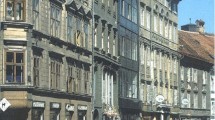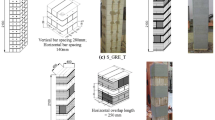Abstract
The article deals with the issues of the strengthening and stabilisation of stone masonry columns reinforced by fabrics based on inorganic fibres under concentric compression. These structures represent a frequent design solution of load-bearing structures of historic buildings. High-strength carbon fibres fabric placed along the perimeter of a masonry column—in thirds of the column height—prevents the undesirable redistribution of compressive normal stresses along the compressed element’s cross section in the phase of crack propagation and crack development. In this phase, despite growing horizontal and vertical deformations (mainly in the central part), a masonry element is able to transfer the growing compressive load. In this case, a gradual exhaustion of the ultimate strength of the individual masonry components occurs as a consequence of wrapping in a composite based on high-strength fibres. The experimental research of the failure mechanism of stone columns made of coursed masonry of regular sandstone blocks and coursed masonry of irregular (freestone) blocks under concentric compression and the research of the performance of non-reinforced as well as CFRP-reinforced stone columns completed to-date reveals the necessity of a different approach to the assessment of the load-bearing capacity, or residual load-bearing capacity, of masonry composed of stone blocks.








Similar content being viewed by others
References
Doran B, Koksal HO, Turgay T (2009) Nonlinear finite element modeling of rectangular/square concrete columns confined with FRP. Mater Des 30:3066–3075
Wu YF, Jiang Ch (2012) Effect of load eccentricity on the stress–strain relationship of FRP-confined concrete columns. Compos Struct 98:228–241
Lignola GP, Prota A, Manfredi G (2012) Numerical investigation on the influence of FRP retrofit layout and geometry on the in-plane behavior of masonry walls. J Compos Constr 16(6):712–723
Luccioni B, Rougier VC (2011) In-plane retrofitting of masonry panels with fibre reinforced composite materials. Constr Build Mater 25:1772–1788
Shrive NG (2006) The use of fibre reinforced polymers to improve seismic resistance of masonry. Constr Build Mater 2006(20):269–277
Zhao T, Zhang CJ, Xie J (2003) Experimental study on earthquake strengthening of brick walls with continuous carbon fibre sheet. Masonry Int J 16(1):21–25
Corradi M, Grazini A, Borri A (2007) Confinement of brick masonry columns with CFRP materials. Compos Sci Technol 67:1772–1783
Faella C, Martinelli E, Paciello S, Camorani G, Aiello MA, Micelli F, Nigro E (2011) Masonry columns confined by composite materials: experimental investigation. Compos B 42:692–704
Aiello MA, Micelli F, Valente L (2007) Structural upgrading of masonry columns by using composite reinforcements. ASCE J Compos Constr 11(6):650–658
Aiello MA, Micelli F, Valente L (2009) FRP confinement of square masonry columns. ASCE J Compos Constr 13:148–158
Lignola GP, Prota A, Manfredi G (2009) Nonlinear analyses of tuff masonry walls strengthened with cementitious matrix-grid composited. ASCE J Compos Constr 13:243–251
Marcari G, Oliveira DV, Fabbrocino G, Lourenço PB (2011) Shear capacity assessment of tuff panels strengthened with FRP diagonal layout. Compos B 42:1956–1965
Micelli F, De Lorenzis L, La Tegola A (2004) FRP-confined masonry columns under axial loads: analytical model and experimental results. Masonry Int J, Ed. British Masonry Society 17(3):95–108
Vasconcelos G, Lourenço P (2009) Experimental characterization of stone masonry in shear and compression. Constr Build Mater 23:3337–3345
Camli US, Binici B (2007) Strength of carbon fiber reinforced polymers bonded to concrete and masonry. Constr Build Mater 21:1431–1446
Carrara P, Ferretti D, Freddi F (2013) Debonding behavior of ancient masonry elements strengthened with CFRP sheets. Compos B 45(1):800–810
Faella C, Camorani G, Martinelli, Paciello S, Perri F (2013) Bond behaviour of FRP strips glued on masonry: experimental investigation and empirical formulation. Constr Build Mater 31:353–363
La Mendola L, Failla A, Cucchiara C, Accardi M (2009) Debonding phenomena in CFRP strengthened calcarenite masonry walls and vaults. Adv Struct Eng 12(5):745–760
Verhoef LGW, van Zijl GPAG (2002) Re-strengthening of brickwork to reduce crack width. Adv Eng Softw 33(1):49–57
Capozucca R (2010) Experimental FRP/SRP-historic masonry delamination. Compos Struct 92:891–903
Ghiassi B, Oliveira DV, Lourenço PB, Marcari G (2013) Numerical study of the role of mortar joints in the bond behavior of FRP-strengthened masonry. Compos B 46:21–30
Kroftová K, Čejka T, Zigler R (2013) Restoration, stabilization and strengthening of heritage buildings with nano-fibre and high-strength fibre based materials. In: Proceedings of the Annual International Conference Architecture and Civil Engineering (ACE 2013), pp 392–397
Kashyap J, Willis CR, Griffith MC, Inghamb JM, Masia MJ (2012) Debonding resistance of FRP-to-clay brick masonry joints. Eng Struct 41:186–198
Kwiecien A (2012) Stiff and flexible adhesives bonding CFRP to masonry substrates—investigated in pull-off test and single-lap test. Arch Civil Mech Eng 12:228–239
Ascione L, Berardi VP, D’Aponte A (2012) Creep phenomena in FRP materials. Mech Res Commun 43:15–21
Mancusi G, Spadea S, Berardi VP (2013) Experimental analysis on the time-dependent bonding of FRP laminates under sustained loads. Compos B 46:116–122
Chowdhury E, Bisby L, Green M, Bénichou N, Kodur V (2012) Heat transfer and structural response modelling of FRP confined rectangular concrete columns in fire. Constr Build Mater 32:77–89
Di Ludovico M, Piscitelli F, Prota A, Lavorgna M, Mensitieri G, Manfredi G (2012) Improved mechanical properties of CFRP laminates at elevated temperatures and freeze–thaw cycling. Constr Build Mater 31:273–283
ČSN EN 1996-1-1, Eurocode 6: Design of masonry structures-Part 1-1: general rules for reinforced and unreinforced masonry structures, ČNI, 2007
Witzany J, Čejka T, Zigler R (2009) The analysis of residual load-bearing capacity of historic masonry structures, In: 31st Conference (11th WTA CZ Conference) rehabilitations and reconstructions of buildings 2009, Praha
Čejka T, Holický M, Sýkora M, Witzany J (in press) Strength assessment of historic brick masonry, J Civil Eng Manag
Acknowledgments
The article was written with support from the NAKI DF12P01OVV037 project “Progressive non-invasive methods of the stabilisation, conservation and reinforcement of historic structures and their parts with composite materials based on fibres and nanofibres” funded by the Ministry of Culture of the Czech Republic.
Author information
Authors and Affiliations
Corresponding author
Rights and permissions
About this article
Cite this article
Witzany, J., Zigler, R. Failure mechanism of compressed reinforced and non-reinforced stone columns. Mater Struct 48, 1603–1613 (2015). https://doi.org/10.1617/s11527-014-0257-z
Received:
Accepted:
Published:
Issue Date:
DOI: https://doi.org/10.1617/s11527-014-0257-z




